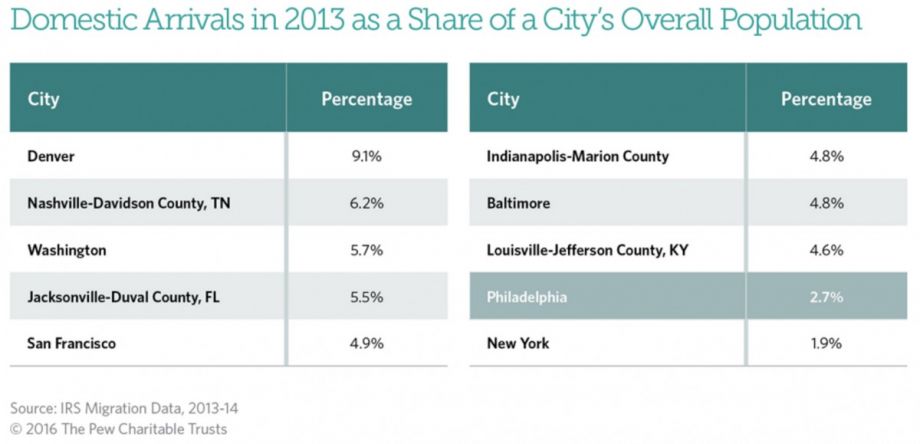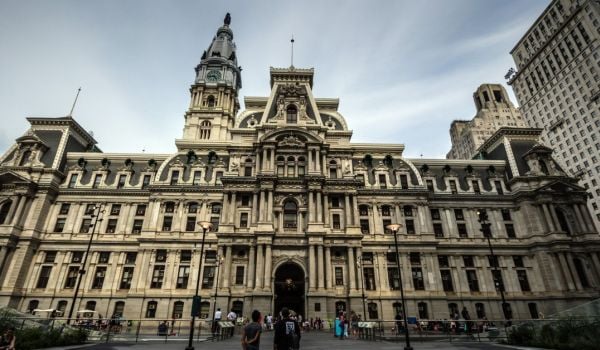Philadelphia’s population has increased every year for the past decade, despite a net outflow of domestic residents, largely fueled by foreign immigrants and a higher margin of births over deaths. Between 2011 and 2013, those who did move to or from the city have very different characteristics from the current composition of the broader population, suggests new research from Pew. Far more people moved within Philadelphia than to or from the city in that time period, but they largely don’t look like the newcomers or the departures, resembling far more closely the city as a whole.
Among the roughly 42,700 people who migrated to Philly between 2011 and 2013, and the 55,000 people who left, non-Hispanic whites and college graduates were overrepresented. Among newcomers, 50 percent were white, compared to 36 percent of Philadelphia’s overall population. Only 20 percent were black, in a city where 42 percent of residents are. Fifteen percent were Asian, compared to 7 percent citywide. (At 13 percent, Hispanic migration was consistent with the city’s current makeup.) This pattern of whites being overrepresented among in-migrants was true for 24 of the nation’s 25 largest cities over the same time period, but more pronounced in Philadelphia than in most of the others.
According to the brief, “A Portrait of Philadelphia Migration,” newcomers were also far younger. Thirteen percent of all residents were between the ages of 18 and 24, but 38 percent of newcomers were. Of these, more than two-thirds were enrolled in higher education. With an additional 27 percent of new arrivals between the ages of 25 and 34, 65 percent of all newcomers were between 18 and 34. According to Pew, that is 9 percentage points higher than the median for the 25 largest cities in the U.S. Just under half of those leaving fell in the same age group. Departures outnumbered arrivals among adults ages 35 to 64 and among children under 17. The report notes that the data — culled from the census — does not include why people left the city, but that the net outflow of children seems to validate fears that families would leave the city due to ongoing concerns about public schools.
The largest share of new arrivals, 23 percent, moved into Center City and adjacent neighborhoods, an area that holds only 9 percent of the city’s population. About half of those who left remained in the 11-county metropolitan area, and the same holds true for those who moved in. In 2013, the majority of newcomers from outside the region came from New York City — and that’s precisely where the majority of departing migrants went. Los Angeles County was the second most common origin point, followed by Allegheny County, Pennsylvania (Pittsburgh), Washington, and Cook County Illinois (Chicago). The second-highest percentage of departures were for Travis County, Texas, where Austin is located, followed by Los Angeles County; Cook County, Illinois; and Baltimore.

Those moving into or out of the city also tended to have higher educational attainment than those remaining. Among people ages 25 or older, 51 percent of new arrivals and 42 percent of departures had at least a bachelor’s degree, compared to about 25 percent of the overall population. Nationwide, people who move between counties tend to be better educated than those who do not move at all or move within a county. This holds true in Philadelphia. A separate policy brief by Pew about migration within Philadelphia showed that those moving place to place within the city had slightly less formal education than the rest of the population, and much less than in or out migrants. Of those 18 or older, 22 percent of movers had less than a high school diploma, compared to 18 percent of all Philadelphians and 10 percent of newcomers. Only 22 percent of movers within the city had college degrees, compared to 23 percent for all residents and 41 percent for newcomers.
Intracity movers were also poorer, again consistent with national trends. Poverty, Pew notes, is often associated with instability; moves tend to be short, rather than long-distance. Forty percent of movers lived in households making less than $25,00 annually; one in six had household incomes less than $10,000. Between 2011 and 2013, 31 percent of the overall population had a household income less than $25,00; one in nine lived in a household making less than $10,000.
Far more people made a move within the city between 2011 and 2013, on average 156,900 people. They also skewed younger than the population as a whole, but not as young as the in or out migrants. Eleven percent of intracity movers were under age 6, compared to 8 percent of all city residents. Forty-three percent were between the ages of 18 and 34; only 29 percent of the city’s overall population is. Hispanic people were overrepresented among movers, making up 18 percent, compared to 13 percent in the overall population. Whites were underrepresented.
Overall, in 2013, Philadelphia saw relatively low migration from other places in the U.S., compared to those moving to other large cities. Domestic arrivals represented only 2.7 percent of the city’s overall population, compared to 4.9 percent of San Francisco, for example.
Next City’s coverage of Philadelphia’s changing neighborhoods is made possible with the support of the William Penn Foundation.
Jen Kinney is a freelance writer and documentary photographer. Her work has also appeared in Philadelphia Magazine, High Country News online, and the Anchorage Press. She is currently a student of radio production at the Salt Institute of Documentary Studies. See her work at jakinney.com.
Follow Jen .(JavaScript must be enabled to view this email address)
















